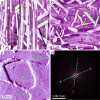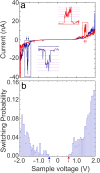Highly distinguishable isomeric states of a tripodal arylazopyrazole derivative on graphite through electron/hole-induced switching at ambient conditions
- PMID: 40726596
- PMCID: PMC12302408
- DOI: 10.3762/bjoc.21.112
Highly distinguishable isomeric states of a tripodal arylazopyrazole derivative on graphite through electron/hole-induced switching at ambient conditions
Abstract
Manipulating the energy barrier and extending the half-life of nonequilibrium states in photochromic switches presents viable solutions for applying them in molecular electronics. Typically, the half-life of the Z isomer of azobenzene (AB) is a few days. Arylazopyrazole-based molecular switches are one of the profoundly explored systems in recent times due to their superior bidirectional photoswitching and long half-life (over a thousand days at room temperature) of Z isomers. Herein, we utilize an efficient solid-state photoswitchable fluorinated tripodal N-functionalized arylazo-3,5-dimethylpyrazole derivative (FNAAP) to envisage and access multiple metastable states on the surface. The tripodal molecule forms well-ordered, large crystalline domains on graphite through non-bonding interactions between the molecules. By injecting electron/hole pairs into the self-assembled molecules on a surface using a scanning tunneling microscope (STM) tip, they are switched between 8 states (EEE, EEZ, EZE, ZEE, EZZ, ZEZ, ZZE and ZZZ) in a tunneling junction at ambient conditions. Contrary to the degeneracy-controlled four states in solution phase, all the eight states are remarkably stable on the surface and are well distinguishable by the tunneling current passing through the molecule at the tunneling junction. The change in current upon switching between these states is approximately an order of magnitude. This is particularly notable at positive sample voltage compared to negative sample voltage. The exceptional stability of the states at ambient conditions provides an opportunity to use a single FNAAP molecule as an 8-bit operation unit, with a potential storage capacity of ≈200 Tbits per 1 cm2 area using an atomically precise write and read tool like an STM tip.
Keywords: azo compounds; electron/hole-induced isomerization; isomerization; molecular switches; switching.
Copyright © 2025, Malik et al.
Figures





Similar articles
-
Sexual Harassment and Prevention Training.2024 Mar 29. In: StatPearls [Internet]. Treasure Island (FL): StatPearls Publishing; 2025 Jan–. 2024 Mar 29. In: StatPearls [Internet]. Treasure Island (FL): StatPearls Publishing; 2025 Jan–. PMID: 36508513 Free Books & Documents.
-
Variation within and between digital pathology and light microscopy for the diagnosis of histopathology slides: blinded crossover comparison study.Health Technol Assess. 2025 Jul;29(30):1-75. doi: 10.3310/SPLK4325. Health Technol Assess. 2025. PMID: 40654002 Free PMC article.
-
Short-Term Memory Impairment.2024 Jun 8. In: StatPearls [Internet]. Treasure Island (FL): StatPearls Publishing; 2025 Jan–. 2024 Jun 8. In: StatPearls [Internet]. Treasure Island (FL): StatPearls Publishing; 2025 Jan–. PMID: 31424720 Free Books & Documents.
-
Systemic pharmacological treatments for chronic plaque psoriasis: a network meta-analysis.Cochrane Database Syst Rev. 2017 Dec 22;12(12):CD011535. doi: 10.1002/14651858.CD011535.pub2. Cochrane Database Syst Rev. 2017. Update in: Cochrane Database Syst Rev. 2020 Jan 9;1:CD011535. doi: 10.1002/14651858.CD011535.pub3. PMID: 29271481 Free PMC article. Updated.
-
A rapid and systematic review of the clinical effectiveness and cost-effectiveness of paclitaxel, docetaxel, gemcitabine and vinorelbine in non-small-cell lung cancer.Health Technol Assess. 2001;5(32):1-195. doi: 10.3310/hta5320. Health Technol Assess. 2001. PMID: 12065068
References
-
- Aviram A, Ratner M A. Chem Phys Lett. 1974;29:277–283. doi: 10.1016/0009-2614(74)85031-1. - DOI
LinkOut - more resources
Full Text Sources
